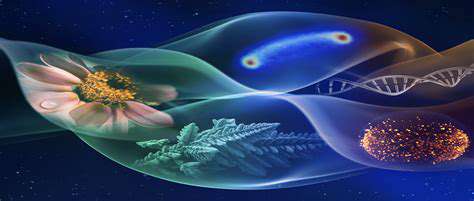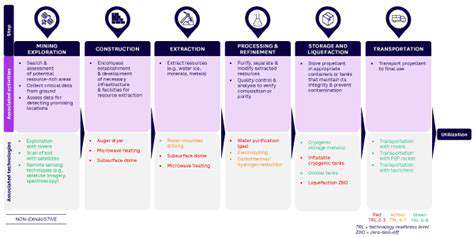The Intriguing Quest for Life Beyond Earth
The Search for Biosignatures
The quest for life beyond Earth hinges on identifying biosignatures—chemical or physical indicators of past or present life. These can range from the presence of specific gases in a planet's atmosphere, like oxygen or methane, to the detection of unusual patterns in the spectral composition of a celestial body's surface. Scientists meticulously analyze data from telescopes and spacecraft, searching for anomalies that might suggest the existence of biological processes, even if they differ dramatically from life as we know it on Earth.
Finding these biosignatures is a complex challenge, requiring sophisticated instruments and rigorous analysis. We must consider that the conditions on other planets might be vastly different from those on Earth, leading to vastly different biosignatures. Therefore, the search for life beyond Earth necessitates a flexible and adaptable approach to identifying and interpreting potential signs of life.
Exploring Extremophiles on Earth
Understanding the limits of life on Earth is crucial for recognizing potential life forms beyond our planet. Extremophiles, organisms that thrive in extreme environments like hydrothermal vents, acidic hot springs, and deep underground, demonstrate the remarkable adaptability of life. Studying these organisms can provide insights into the potential for life to exist in environments deemed uninhabitable by conventional standards. This research is vital for refining our understanding of the conditions necessary for life to emerge and persist, expanding our search criteria for extraterrestrial life.
By studying extremophiles, scientists gain a deeper understanding of the fundamental requirements for life. This knowledge can inform the design of instruments and strategies for searching for life beyond Earth, potentially revealing biosignatures in environments previously considered too harsh for biological activity. The diversity and resilience of extremophiles on our planet offer a profound glimpse into the adaptability of life and potentially the diverse forms life might take beyond Earth.
The Role of Space-Based Telescopes
Space-based telescopes are essential tools in the search for life beyond Earth. Their position above Earth's atmosphere allows for unobstructed observation of the cosmos, enabling scientists to gather data with unprecedented clarity and detail. Powerful instruments like the James Webb Space Telescope (JWST) can analyze the light from distant planets and stars, providing valuable information about their composition and potential habitability. These observations can reveal the presence of biosignatures, like the absorption of light by specific molecules, offering clues about the possible existence of life.
Developing Advanced Detection Techniques
As we delve deeper into the universe, the need for increasingly sophisticated detection techniques becomes paramount. Scientists are constantly developing new methods to analyze data from space missions and astronomical observations. These advancements include improved spectral analysis, more precise measurements of planetary atmospheres, and the integration of artificial intelligence algorithms to identify subtle patterns that could indicate the presence of life. The continuous refinement of our analytical tools is critical for improving our chances of finding extraterrestrial life.
The Philosophical Implications of Discovery
The discovery of life beyond Earth would have profound implications for our understanding of the universe and our place within it. It would fundamentally alter our perspective on the prevalence of life, challenging our assumptions about the uniqueness of Earth. The implications extend beyond the scientific realm, touching upon philosophical questions about the nature of existence, the origin of life, and our responsibilities as stewards of the universe. The potential discovery of life beyond Earth would spark a global conversation about the ethical implications of contact and the potential impact on human society.
The Role of Microgravity and Extreme Environments in Biological Research
Microgravity's Impact on Cellular Processes
Microgravity, the near-weightlessness experienced in space, presents a unique environment for studying biological processes. The absence of gravity fundamentally alters how cells behave and interact. This lack of gravitational pull affects cellular signaling pathways, impacting everything from protein synthesis to cell division. Researchers can use these alterations to gain insights into fundamental biological mechanisms, potentially leading to advancements in understanding disease and developing new treatments. Studying the effects of microgravity on cell cultures in space allows scientists to observe these changes in a controlled environment, free from the confounding variables found on Earth.
One particularly intriguing area of research focuses on bone density loss in space. Astronauts frequently experience significant bone loss during missions, highlighting the crucial role of gravity in maintaining skeletal health. Understanding the specific molecular mechanisms behind this bone loss in a microgravity environment is paramount to developing countermeasures, such as exercise regimens and nutritional strategies, to mitigate these effects and safeguard the health of future space explorers and even patients on Earth with bone-related diseases.
Extreme Environments and Evolutionary Adaptations
Beyond the confines of microgravity, extreme environments, such as those found on Earth at high altitudes or in the deep ocean, offer valuable insights into biological adaptations. These extreme conditions often select for unique traits and physiological adaptations that can provide clues about the resilience and plasticity of life. Studying organisms in these environments can lead to a deeper understanding of evolutionary pressures and the remarkable ways in which life adapts to challenging conditions.
For example, organisms living in high-altitude environments often exhibit adaptations in their respiratory systems, allowing them to efficiently absorb oxygen at lower atmospheric pressures. By studying these adaptations, researchers can develop novel strategies for improving human performance in high-altitude environments, such as during mountaineering expeditions or at high-altitude military bases. Understanding how organisms survive in these extreme conditions can also reveal fundamental principles of biology applicable to other areas of research, including human physiology and medicine.
Biological Research in Simulated Extreme Environments
The study of biological processes in extreme environments isn't solely limited to space or Earth's extremes. Researchers are also increasingly using simulated extreme environments on Earth to study biological responses. This approach allows for greater control over experimental conditions and the ability to conduct repeated experiments under defined parameters. This includes creating controlled environments to mimic the effects of high radiation, high temperatures, or specific nutrient deficiencies. These simulations can be used to study the effects of environmental stressors on various organisms, including microbes, plants, and animals.
These laboratory-based simulations can directly inform strategies for protecting crops from extreme weather, developing more resilient agricultural practices in harsh environments, and potentially even developing more robust space habitats. Essentially, these simulated environments allow for the study of biological resilience in a way that is more efficient and accessible than actual space missions or expeditions to remote locations. It facilitates a more detailed understanding of how life adapts to the challenges posed by extreme environments.
The creation of controlled environments also allows for the investigation of the impact of environmental contaminants on various organisms, and the development of strategies for remediation and protection. This research is crucial for understanding the effects of pollution in various ecosystems and developing effective approaches to environmental conservation.
Developing Advanced Biological Instruments for Space Missions

Harnessing Cellular Processes
Advanced biological insights often stem from a deep understanding of cellular processes. This intricate interplay of molecules and structures within cells dictates their behavior and, consequently, the function of entire organisms. Researchers meticulously examine these processes, from fundamental metabolic pathways to complex signaling cascades, to uncover novel mechanisms and potential therapeutic targets.
Understanding the dynamic nature of cellular processes is crucial for developing advanced biological interventions. For instance, targeting specific enzymes or signaling molecules can lead to the development of therapies for diseases like cancer or diabetes. This knowledge is vital for manipulating cellular behavior in beneficial ways.
Exploring Genetic Mechanisms
Genetic mechanisms, encompassing DNA replication, transcription, and translation, are fundamental to biological understanding. Decoding the intricate language of genes and their interplay with environmental factors allows researchers to uncover the underlying causes of various biological phenomena. This detailed knowledge is crucial in predicting and preventing diseases or even tailoring treatments to individual genetic profiles.
The study of genetic mechanisms extends beyond the realm of human biology, encompassing the study of genetic diversity and adaptation in various species. Analyzing genetic variations across populations provides insights into evolutionary processes and the response to environmental changes.
Investigating Protein Interactions
Protein interactions are critical for regulating cellular activities. Understanding how proteins interact with each other and with other cellular components is essential for comprehending complex biological processes. Researchers employ sophisticated techniques to map these interactions, providing insights into disease mechanisms and potential therapeutic targets.
This knowledge is invaluable for designing drugs that specifically target problematic protein interactions, offering a novel approach to treating various diseases. This area of research also explores the role of protein modifications in regulating cellular processes.
Utilizing Bioinformatic Tools
Bioinformatics plays a vital role in analyzing biological data, encompassing genomic sequences, protein structures, and gene expression profiles. The sheer volume of data generated by modern biological experiments necessitates sophisticated computational tools to process and interpret the information. These tools allow researchers to identify patterns, predict protein functions, and model complex biological systems.
Bioinformatics is essential for accelerating biological discoveries. By enabling rapid data analysis, it allows researchers to make significant strides in understanding biological processes and developing novel therapeutic approaches.
Developing Novel Imaging Techniques
Advanced imaging techniques are essential for visualizing cellular structures and processes at various scales. From electron microscopy to super-resolution microscopy, these techniques provide detailed insights into cellular organization and dynamic behavior. These imaging tools are indispensable for studying the intricate mechanisms governing cellular function.
These advancements in imaging technology enable researchers to visualize biological processes in real time, allowing for a deeper understanding of the dynamic nature of cellular activities. This real-time visualization is crucial for comprehending the complexities of biological phenomena.
Addressing Ethical Considerations
As biological research advances, addressing the ethical considerations surrounding these advancements is paramount. The application of advanced biological insights raises important questions about the responsible use of technology and the potential societal implications. Careful consideration of ethical principles is crucial for ensuring that these advancements benefit humanity while minimizing potential harms.
These considerations encompass issues like genetic engineering, gene editing, and the use of biological data. Ethical guidelines and regulations are essential to ensure that research is conducted responsibly and with respect for individual rights and societal well-being.
Optimizing Experimental Design
Rigorous experimental design is fundamental to obtaining reliable and meaningful results in biological research. Carefully designed experiments, incorporating appropriate controls and statistical analyses, are crucial for validating findings and minimizing biases. This meticulous approach ensures that conclusions drawn from biological studies are robust and contribute to a deeper understanding of biological systems.
Optimizing experimental design involves selecting appropriate experimental models, controlling variables, and using appropriate statistical methods to analyze results. This careful approach is essential to ensure the validity and reliability of scientific findings.




